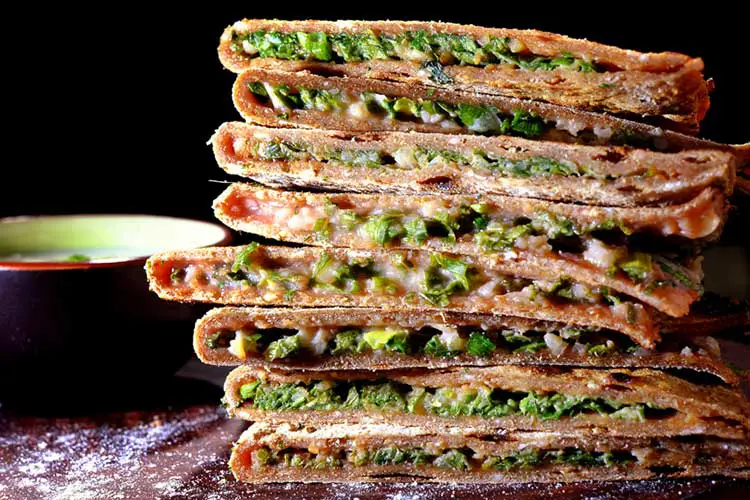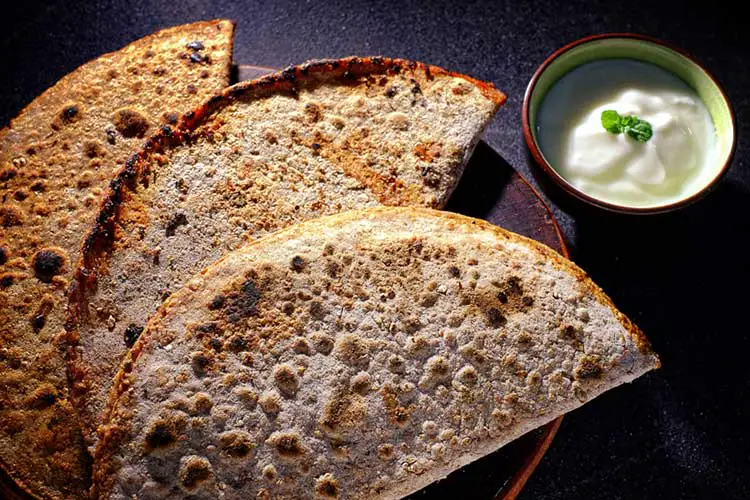More robust than a crepe, more delicate than bread, the Azerbaijani kutab is a kind of flatbread-pancake stuffed with a variety of possible fillings from pumpkin or cheese to spinach, offal, herbs, and even camel meat.
A more cavalier commentator might pass it off as a regular sandwich, but we think that would be massively underselling the art of mixing and browning the perfect pastry and balancing it with just the right amount of filling.

KUTAB, THE KITCHENS OF GOBUSTAN AND PREHISTORIC COOKING
Azerbaijan’s kutab is a versatile regional bite that has many incarnations in its home country: towns like Baku, Shamakhi and even the seaside village of Jorat have their own takes on the kutab, while the dish actually goes by another name in other parts of the country, such as ‘afar’ in Sheki-Zaqatala and ‘kata’ in Karabakh. Those familiar with Turkish food might also pick up on the resemblance to gözleme as well as other stuffed flatbreads that stretch all the way from the Middle East to India.
AZERBAIJANI COOKING HISTORY
People have been cooking in Azerbaijan for a verrrrrry long time. Look no further than the jaw-dropping Gobustan Rock Art Cultural Landscape south west of the capital Baku – a UNESCO-protected complex of ancient petroglyphs and rock carvings that date back as far as 40,000 years. Here you’ll find the Gobustan Kitchens, a series of prehistoric cooking bowls carved into the rock that were most probably used for cooking or collecting rainwater/the blood of sacrificed animals. And among the myriad carvings at Gobustan are images of hunting and fishing; echoes of a vibrant culinary culture that stretches back into the fog of the past.
Another clue to Azerbaijan’s food cornucopia is the diversity of landscape and range of climates given the size of the country. As such, pretty much anything that wants to grow, can grow somewhere on Azeri soil. The range of locally available ingredients is vast, and the country’s current crops range from rice, figs, grapes, tomatoes, saffron, pomegranate, tarragon, almonds, quince, cherry-plums to name a few, and there is plenty of sheep and cattle farming.
To the west of Azerbaijan is its sworn enemy Armenia (against whom it has fought and is still in a diplomatic rut with over the disputed territory of Nagorno-Karabakh) and the Caucasus mountains, with Georgia and Russia to the north and Iran to the south. Due to its geographic ease of access and very central position along ancient trade routes, Azerbaijan has had a complicated history. More recently been tossed between Iran and Russia, the region long stood as a corridor for other conquering nations over the centuries, from the early Medes and the Scythians to the Mongols and Seljuk Turks to several invasions by the Ottoman armies.
COOKING WITH DRAGON FIRE
Fire and oil are twin legendary and economic cornerstones of Azerbaijan. With Baku primarily an oil drilling city taking its bounty from the reserves that lie under the Caspian Sea, there is plenty of excess petroleum under the ground – so much so that some of it actually escapes to the surface through fissures in rock and gives rise to spontaneous fires. About 10 miles north of Baku in this once-Zoroastrian region is a fire mountain called Yanar Dag whose eerie perpetual flames inspired travelers from days of yore to attribute the phenomena to legendary monsters or dragons.
Fire still plays a big part in Azerbaijani cooking, with the clay oven – the tandir – an important element in the cuisine of a country that consumes large amounts of bread. The saj, an iron pan upon which the kutab is grilled, can be flat (for our purposes here) or concave. The latter is used ingeniously – either as a wok-like receptacle for frying, or turned upside down and placed on a fire (dragon breath optional) to serve as a burning hot surface for laying out bread to cook.
SOVIET SUSTENANCE
These central Asian cooking methods reigned supreme in Azerbaijan up until it was absorbed into the Soviet Union in 1920. From then on the standardizing force of the Soviet vision seeped onto the plates of Azerbaijanis who were increasingly feeding themselves in government-run cafeterias, which were free of charge. These eateries were heavy on Russian fare, the likes of borscht and goulash, which were slowly absorbed onto the national palate and began to significantly change the face of Azerbaijani cuisine, as did the popularization of alcohol.
The Soviets did, however, recognize Azerbaijan’s tremendous potential as a farming region, and as such the area of Lankaran, situated near the border with Iran, was known as the “All-Union Garden” for its abundant output of cabbages, tomatoes, eggplant and peppers.
ABOUT THE RECIPE
Of all the different types of kutab, we’ve decided to go with the herb (goyerti) variety because we think it best embodies the simplicity of the principle of kutab. Having said that, we are looking forward to experimenting with other traditional fillings like pumpkin and who knows maybe one day some ground camel meat. The latter is becoming less prolific even in Azerbaijan, where there’s been a drop in the number of camels in the country since the 1960s.
We’ve come up with a selection of herbs to stuff the kutab with, but do bear in mind our list is not exclusive. In the land of herb plenty that is Azerbaijan, there are many more options usually put into a kutab, including dill, parsley and leeks.
Most green kutab recipes also call for lavashana, which is sour prune pulp that has been pressed and dried, but this ingredient is quite tricky to source outside of Azerbaijan. As such, we decided to go for pomegranate molasses as an alternative.
PREPARING THE HERBS
Wash and dry all the herbs, greens and onions and gently chop them, taking care to keep them crisp and not to let them get mushy.
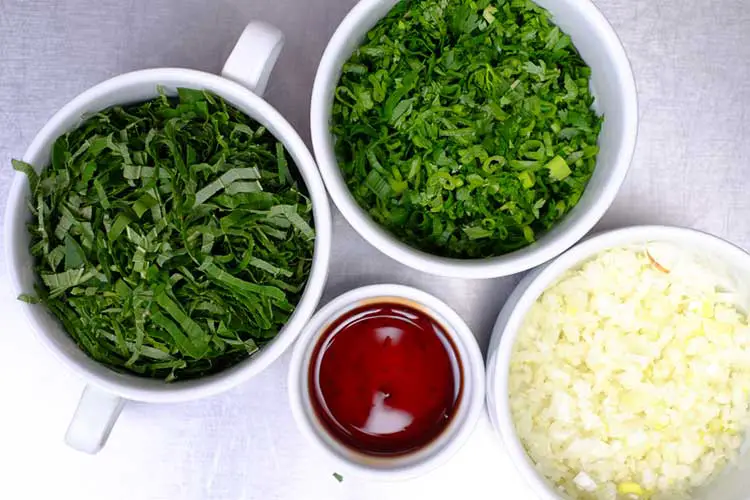
Then beat the egg together with the two teaspoons of yogurt.
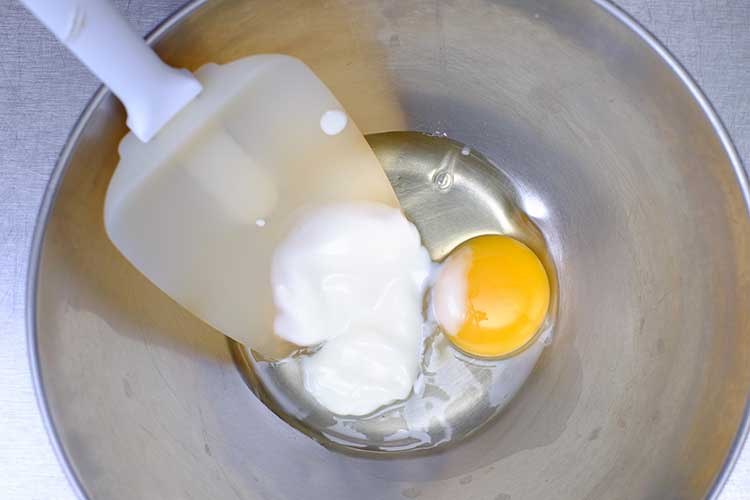
Then mix the egg and yogurt together with the chopped onions, the chopped spinach, sorrel, and herbs.
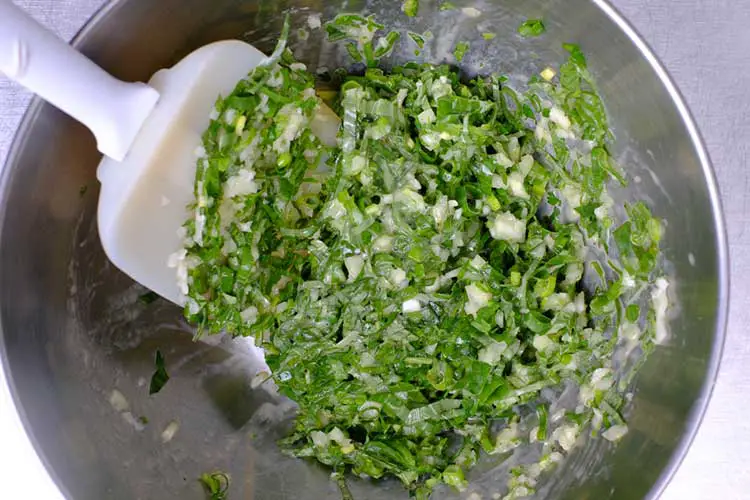
Now it’s time to work on the pastry for the pancakes. Get your ingredients ready.
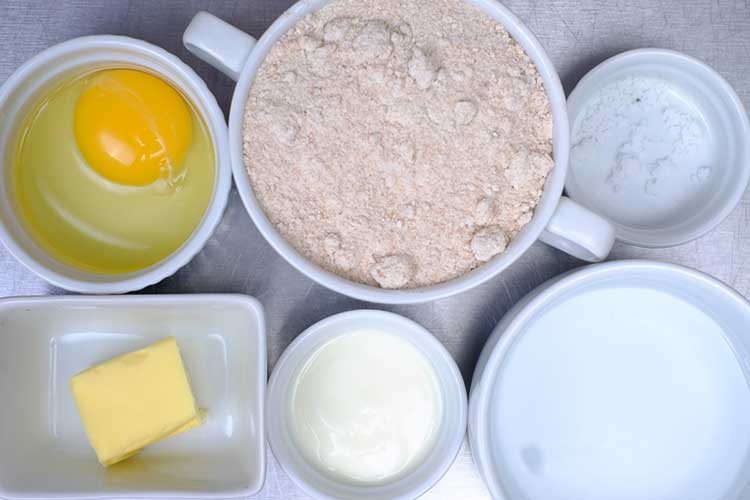
Mix the wheat flour, egg, salt, yogurt, and water well in a mixing bowl until a ball of dough is formed.
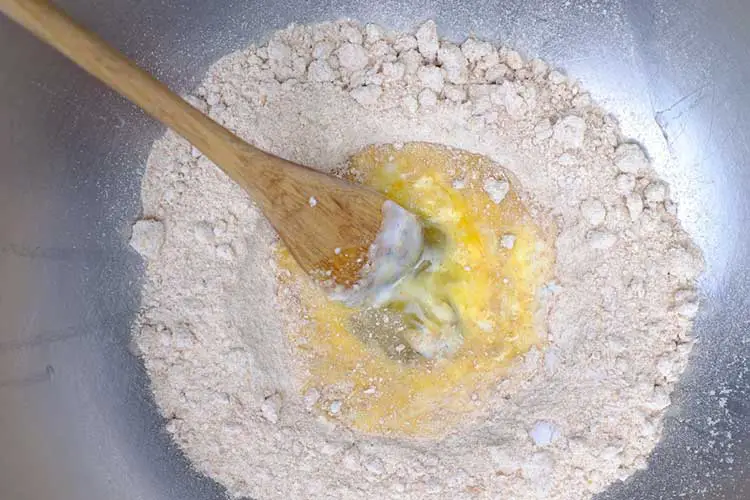
Divide the dough into equal portions. A great way of doing this is by checking each one on a scale. They should weight about 100g each. Be sure to work on your dough while its fresh and moist. If you leave it out to air for too long, it’ll become brittle and will crack when you try to roll it out.

Now flatten the dough ball on a floured surface and roll out into a large circle with a rolling pin. You want the final product to be about 3mm thick. Rolling out the dough into uniform thickness and diameter may be quite a challenge, depending on your baking skills. One hack we know of is to roll the dough out into one large sheet and cut it into uniform sizes by laying a small plate over the sheet and running a knife around the edge.

Spread a layer of lavashana over the top of the kutab, to cover most of the surface.
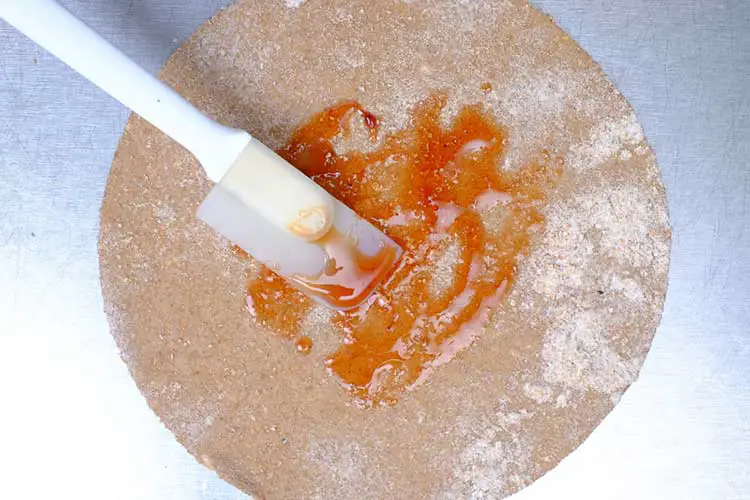
The spread the herb mixture over half of the area of the circle.
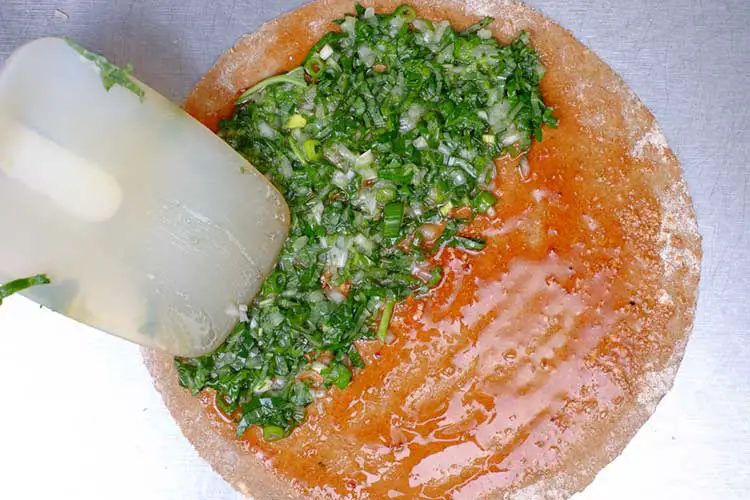
Fold the empty half of the kutab over to make a semi-circle.
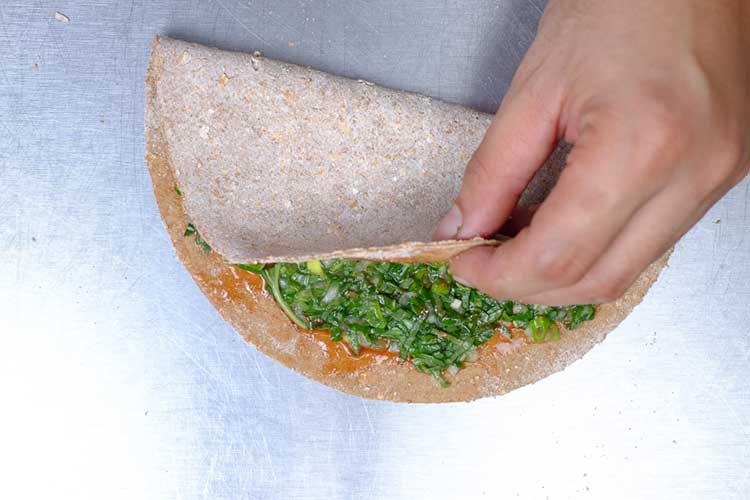
Toast each kutab on a hot, non-stick skillet (in the event that you don’t have a saj lying about the house) for 2-3 minutes on each side. Don’t bother oiling the skillet as the dough will easy absorb the oil, making your kutabs soggy and greasy.

Once grilled, brush each side of the kutab with melted butter of ghee before serving. Serve it up with a side of yogurt – which is often spread directly onto the surface of the kutab. Another great accompaniment is a glass of ayran, the classic yogurt drink which you can make yourself at home by mixing equal parts yoghurt and water, then adding a pinch of salt and a squeeze of lemon.
Nush olsun!
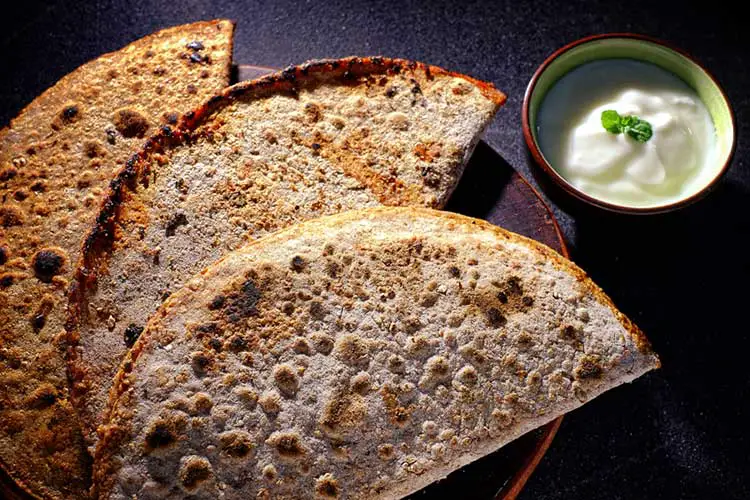
OUR TAKE ON THE RECIPE
The kutab is one of the more simple dishes we’ve recently made. To us, it tasted a lot like herb-stuffed quesadilla; a toasted wheat taco, with a hint of sweetness from the pomegranate molasses, and freshness from the chopped herbs.
The source recipe we worked from emphasized the importance of sorrel in the dish for really bringing home the authentic flavor of the kutab, and suggested adding lemon juice to the herb mixture, should sorrel not be available.
The most challenging part of the process was getting the dough right, and we came to realize that it’s a step in the process that’s worth spending time on. It was important to make sure all the dough balls were of an equal weight and that they were evenly rolled out into circles. Having the right utensils is always a good start – a regular rolling pin will do, but in Azerbaijan the pastry chefs use a much thinner, lighter version to spread out their dough – a pin more akin to a drumstick.
Our bread eventually came out a lot crispier than a traditional kutab, whose pastry is usually much softer and more supple. Perhaps we could have rolled it thinner. Having said that, our favorite thing about our kutabs was the dough; we loved the consistency and crunch.
However, our taste jury is out on the particular filling that we chose, as we felt that the individual components just didn’t come together in harmony as they hit the palate. It did feel a bit like taking mouthfuls of bread, jam and herbs all at the same time, which honestly is not our idea of a great sandwich. When we make kutab again, we’ll be trying some grilled meat, vegetables, and maybe some kind of savory sauce to amp up the flavors… though we might hold off on camel for now.
